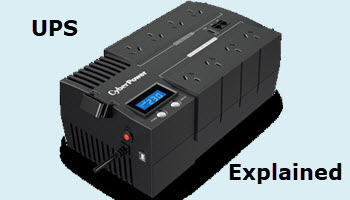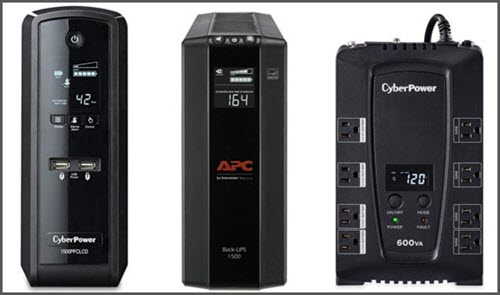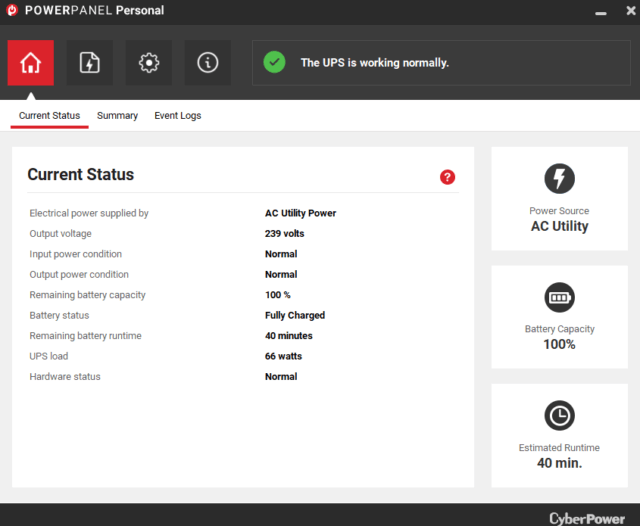An Uninterruptable Power Supply (UPS) is essentially a battery backup that continues powering your devices after a power outage. Plus, of course, a UPS will provide protection against damage caused by power surges. But I’m pretty sure most of you would already be aware of all that.
It’s important to note that UPS batteries supply power for only a relatively short period of time and are not designed to power a PC for any extended length of time.
Unfortunately, UPSs are not always viewed as an integral piece of equipment and, I must admit that until quite recently, I was as guilty as anyone. However, having now owned and used a UPS connected to my main machine for a little over 12 months, I am a convert and fan. As is the case with most of my purchases, I researched UPSs thoroughly before taking the plunge and what follows is based on that research plus firsthand experience since.
UPS Models & Output
As usual, I can only attest to what’s available in Australia. There are two main UPS brands, APC and CyberPower. APC brand UPSs are slightly more expensive here than the equivalent CyberPower models but the overall specs are generally very similar. I ended up going with the CyberPower brand based purely on economics.
UPSs are rated by power output, which is the maximum load that can be drawn from the UPS at a given moment. Each UPS’s maximum power output is designated by a VA (Voltage-Amps) rating which is often included as part of the model’s description and always in the specs. These ratings for home UPSs generally start at 600VA and increase incrementally through to 2200VA with prices increasing exponentially. You will also find the maximum output wattage listed in the specs but this can also be calculated from the VA rating – divide the VA rating by 10 and then multiply the result by 6. For example, a rating of 800VA divided by 10 = 80 x 6 = 480 watts.
UPS Outlets
All UPSs come with at least two outlets to connect your devices and the number of outlets will often increase with higher VA ratings and prices. Outlets can be battery + surge or a mixture of battery + surge and surge only. Obviously, you’d connect your most vulnerable devices, such as a PC, to the battery + surge outlets, and other less critical equipment can be connected to the surge-only outlets. Many models also include phone/network protection with one input and one output (RJ11/RJ45 Combo).
The UPS is connected to the PC via a USB cable, very similar to a printer’s cable, which is included with the package, and you can connect only one PC per UPS.
NOTE: Never connect a laser printer to a UPS as the power drawn by these printers is far in excess of what the UPS can handle and will almost certainly result in an overload.
UPS Management Software
Both APC and CyberPower provide free software which the user needs to download and install. APC’s free software is called PowerChute Personal Edition and CyberPower’s is called PowerPanel Personal. The software communicates with the UPS and reports on its status, including lots of useful information, plus settings for users to configure certain actions/behavior.
UPS Technology
Pretty much all home UPSs come with Line-interactive topology which includes an Automatic Voltage Regulator (AVR) to correct any irregularities without needing to switch to the backup battery. This results in prolonged battery life and also provides enhanced protection against under and overvoltage. This is the best UPS type to use for the protection of home computers.
And all come with “simulated sine wave” as the “on battery waveform”. The simulated sine wave is a much less expensive version of pure sine wave but is more than adequate for home use. Pure sine wave UPSs are very expensive.
Batteries: User-Replaceable Or Not?
Some UPSs allow for the batteries to easily be replaced by the user, usually in the more expensive models, while in many cheaper models the batteries are not replaceable. Replacement batteries are not cheap so the decision here has to be tempered with a little common sense.
Obviously, if you purchase one of the more expensive UPSs, you should make sure that the battery is user replaceable. However, with the less expensive models, it is not so critical. You may well find that the price difference between buying a replacement battery and buying a brand-new equivalent model is negligible.
If you do end up deciding to buy a UPS with a user-replaceable battery, I would suggest checking the price of the replacement batteries before making that final decision.
Which UPS Is Right For You?
Well, the answer to that one obviously depends on each individual’s requirements. High-end gaming machines with advanced graphics cards will obviously require a more powerful UPS than a basic machine. Ascertaining the exact wattage a system requires is not easy but you can gain some insight by utilizing one of the many online PSU calculators – PSU wattage requirements roughly equate to UPS wattage requirements. Or ask an expert at the UPS store. To give you some idea, here are the two CyberPower models I bought and the specs for each machine.
These are the specs for my main (newer) machine: Intel i7-11700 CPU, integrated Intel graphics 750, 16GB DDR4 RAM, Intel 512GB NVMe drive, Samsung 250GB 850 EVO SSD – and this is the CyberPower model I chose: CyberPower Bric BR850ELCD.
This one comes with 4 battery + surge outlets and 4 surge-only outlets which, I now realize was slight overkill. It has a maximum 510 watts capacity which, during four subsequent power outages, has proved to be more than adequate. The “Bric” format, with all outlets on top, was most suitable for my space, more so than the tower format which comes with outlets at the back.
These are the specs for my secondary (older) machine: Intel i5-4460 CPU, NVIDIA GeForce GT 710 GPU, 8GB DDR3 RAM, Samsung 250GB 850 EVO SSD – and this is the CyberPower model I bought: CyberPower Value 800EI.
I had more open space for this one so it’s the more traditional tower format with just two battery + surge outlets at the back – one for the PC and one for the monitor. It hasn’t been tested out with a power outage as yet but with a capacity of 480 watts output, plus sporting much older hardware than the newer machine, I’m confident it will do the job just fine.
BOTTOM LINE:
When I reflect on all those years without a UPS and with just a few instances of damaged hardware due to unforeseen power outages during that time, I now realize just how lucky I have been. Now, I would never be without a UPS.
My newer computer cost $1000.00AU and the CyberPower UPS cost $120.00AU. If it lasts for at least 5 years of the battery’s life expectancy, that equates to around 50 cents per week. And that, my friends, is very cheap insurance.
As I mentioned earlier, my firsthand experience with UPSs is somewhat limited so, if you have a UPS and would like to add anything for the benefit of our readers, please feel free to do so via the comments.
—





Jim. Boy am I glad you selected topic. I have used and trusted my computers to UPS devices (APC) for many years. When it comes to selecting the VA rating, I believe the higher 1500va supplies more run time and this is my preferred option. Also, the replacement batteries are about half the cost of a replacement UPS, so after one battery replacement (meaning from the original purchase date and having a lifespan of 8 to 10 years with two batteries), I prefer to purchase a new and more up to date UPS. The other is the companies view point on using extension cords and power bars. Sometime the computer and UPS are not close by, so using an extension cord, and this is where it gets tricky (and why companies frown on mentioning them), the extension cord should (must) be at-least a 14gauge three prong type.
Should one need added outlets, a non surge protection power bar (as having one than one surge protector might defeat the protection process) has worked fine for me. I connect several items that use the large adapter so even 5 outlets is not enough for me at times. But this is not recommended as users tend to disregard instruction and common sense. I currently use one UPS to power my modems and this gives me a runtime of over 3 hours. My computers have a runtime from half an hour to just over two hours.
Footnote: Jan 5 marked the 25th anniversary of that famous ice storm which hit Quebec and caused a major blackout toppling those monster transmission towers, taking out hydro polls with fallen trees, and lasting from several days to several weeks, Mindblower!
Hey MB,
Thanks for sharing your experience here mate, appreciated.
Jim, since you touched on the software part which links the UPS to the computer, the APC units I use also have a voltage readout on the front panel. I have one which somehow I was able to keep the display on (they usually switch off after some time), so I do see the 120 volts go mostly up to 123. And one perk I enjoy seeing, is knowing when the UPS intervened, for how long, for what reason. Yes, I love my gadgets, Mindblower!
Informative article. I have used these units for backups of my internet modem and router, alarms systems, in addition to the regular backups for many, many years. One thing I have noticed with some of the newer 450-750 VA units lately is a lack of the link from the computer to the unit by USB. In fact, there is no way for it to communicate with the backup by computer. These units now sell in the 75-115USD range. To get to a feedback link, you have to spend over 125USD. Considering I build my own towers for about 1000USD (I7 with 32GB and midlevel Graphics) and they will last only 4-5 years max, it is hard to justify spending over 100USD on this. And I use onsite and offsite backups. Maybe they have not changed over yet in Australia to the newer protocols, but they may show up soon like in the USA. BTW, love your country, especially Melbourne and the south shores drives.
Hey Vincent,
I’ve never heard of a battery backup only UPS that it not interfacing with the PC via software. Maybe they are available in Australia but I’ve never come across any.
To my way of thinking, that is not much better than straight out surge protection. A traditional UPS (connected via USB and with interfacing software installed on the PC)) will protect both the hardware and system. One of the main settings in the interfacing software is to shutdown the computer gracefully once the battery power is drained to a certain level.
I’m surprised to hear that your machines last only 4-5 years max. My machines last way beyond that, and I am pretty hard on them. My second (spare) machine right now is still going strong at 9 years old.
Yes, Melbourne and the south shore drives are terrific. I live on the East coast in Bundaberg Queensland, at the start of the tropics.
Thanks for your enlightening comment.
Great coverage of all the points. I say the most important thing is having enough sockets that are backed up and realizing that not all ARE backed up. Then what you stated about Replacing the battery. I had one design that the manufacturer was great about replacing the entire unit and providing a return shipping label and packaging for the old unit. On the other hand, I think the average technogeek is capable of replacing his own battery which many designs permit. Watch out for garbage replacement batteries from places like Cramazon.,
Hi Jim
I have a battery backup on my main PC and also on a pellet heater which has a small motherboard display and electronics that run the pellet motor and settings for the heater.
I was told it was a good idea to buy a UPS for the pellet heater because if the power goes off in mid-burn you will of course lose the air intake and exhaust fans and that apparently can cause smoke issues with nothing to exhaust it. So far touch wood….
I was also advised to get a Pure Sine Wave UPS for the pellet heater as the mainboard controllers can be very sensitive to the power supply signal. Most UPS systems being sold for PCs as far as I know are using Modified Sine Wave. I guess the modern power supplies in today’s PC’s must be able to cope with a modulated sine wave better than the less advanced electronics in the pellet heater module.
As an experiment I once deliberately switched off the power at the switch at least half a dozen times on an old PC running Windows 10 without shutting it down properly through Windows Shutdown. It fired back up into Windows every single time without any issues at all. Of course if I had had unsaved data that would have gone west but at least the operating system seems to cope very well with such crude treatment !
Hey Reg,
Interesting comment.
As per the article, most home UPSs come with “simulated sine wave” technology. I guess “modified” would be close enough… same horse, different name. 🙂
Yes sorry my mistake Jim – the word should have been “modified” sine wave not modulated.I think ‘simulated” is used too.